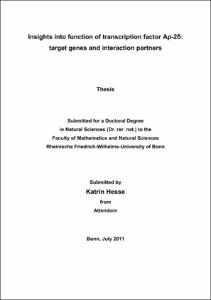Hesse, Katrin: Insights into function of transcription factor Ap-2δ : target genes and interaction partners. - Bonn, 2012. - Dissertation, Rheinische Friedrich-Wilhelms-Universität Bonn.
Online-Ausgabe in bonndoc: https://nbn-resolving.org/urn:nbn:de:hbz:5n-27786
Online-Ausgabe in bonndoc: https://nbn-resolving.org/urn:nbn:de:hbz:5n-27786
@phdthesis{handle:20.500.11811/5276,
urn: https://nbn-resolving.org/urn:nbn:de:hbz:5n-27786,
author = {{Katrin Hesse}},
title = {Insights into function of transcription factor Ap-2δ : target genes and interaction partners},
school = {Rheinische Friedrich-Wilhelms-Universität Bonn},
year = 2012,
month = mar,
note = {The Ap-2 transcription factors comprise a family of sequence-specific DNA-binding proteins that play pivotal roles in regulating gene expression during development, differentiation, and tumorigenesis.
According to the restricted, neural Ap-2δ expression, Ap-2δ knockout mice exhibited enhanced apoptotic cell death in the posterior midbrain resulting in the complete loss of this structure at the newborn state. Transcriptome analysis of posterior midbrains of wildtype and Ap-2δ-deficient mice identified the transcription factors Pitx2, Mef2c, Bhlhb4 and Pou4f3 as de novo Ap-2δ targets. Moreover, Ap-2δ positively mediated activation of the Bhlhb4 and Pou4f3 promoters. Electrophoretic mobility shift assays (EMSA) confirmed the direct binding of Ap-2δ to an Ap-2δ-specific consensus sequence within the Pou4f3 promoter. Consistently, Ap-2δ occupied the promoters of Pou4f3 and Bhlhb4 also in vivo as demonstrated with chromatin immunoprecipitation (ChIP) assays. In summary, the data presented here denote the regulatory activity of Ap-2δ on midbrain-expressed transcription factors as essential for the development of the posterior midbrain.
In the second part of this study, the transcription factor Nfatc2 was identified as a new binding partner for Ap-2δ. The interaction of Nfatc2 and Ap-2δ initially observed in yeast was confirmed in GST pulldown assays and co-immunoprecipitations. The newly identified targets Atm, Egr3, and Mtss1 were found to be downregulated after overexpression of Ap-2δ and ectopic expression of Nfatc2 in Neuro2a cells. Consistently, downregulation of Tcfap2d by siRNA increased transcript levels of these targets indicating for the first time that Ap-2δ also exerts a repressive function. Using ChIP assays, Atm, Egr3, and Mtss1 were identified as direct targets. Taken together, this work demonstrates that Ap-2δ together with Nfatc2 can function as a transcriptional repressor and plays an important role in the regulation of neuronal gene expression.},
url = {https://hdl.handle.net/20.500.11811/5276}
}
urn: https://nbn-resolving.org/urn:nbn:de:hbz:5n-27786,
author = {{Katrin Hesse}},
title = {Insights into function of transcription factor Ap-2δ : target genes and interaction partners},
school = {Rheinische Friedrich-Wilhelms-Universität Bonn},
year = 2012,
month = mar,
note = {The Ap-2 transcription factors comprise a family of sequence-specific DNA-binding proteins that play pivotal roles in regulating gene expression during development, differentiation, and tumorigenesis.
According to the restricted, neural Ap-2δ expression, Ap-2δ knockout mice exhibited enhanced apoptotic cell death in the posterior midbrain resulting in the complete loss of this structure at the newborn state. Transcriptome analysis of posterior midbrains of wildtype and Ap-2δ-deficient mice identified the transcription factors Pitx2, Mef2c, Bhlhb4 and Pou4f3 as de novo Ap-2δ targets. Moreover, Ap-2δ positively mediated activation of the Bhlhb4 and Pou4f3 promoters. Electrophoretic mobility shift assays (EMSA) confirmed the direct binding of Ap-2δ to an Ap-2δ-specific consensus sequence within the Pou4f3 promoter. Consistently, Ap-2δ occupied the promoters of Pou4f3 and Bhlhb4 also in vivo as demonstrated with chromatin immunoprecipitation (ChIP) assays. In summary, the data presented here denote the regulatory activity of Ap-2δ on midbrain-expressed transcription factors as essential for the development of the posterior midbrain.
In the second part of this study, the transcription factor Nfatc2 was identified as a new binding partner for Ap-2δ. The interaction of Nfatc2 and Ap-2δ initially observed in yeast was confirmed in GST pulldown assays and co-immunoprecipitations. The newly identified targets Atm, Egr3, and Mtss1 were found to be downregulated after overexpression of Ap-2δ and ectopic expression of Nfatc2 in Neuro2a cells. Consistently, downregulation of Tcfap2d by siRNA increased transcript levels of these targets indicating for the first time that Ap-2δ also exerts a repressive function. Using ChIP assays, Atm, Egr3, and Mtss1 were identified as direct targets. Taken together, this work demonstrates that Ap-2δ together with Nfatc2 can function as a transcriptional repressor and plays an important role in the regulation of neuronal gene expression.},
url = {https://hdl.handle.net/20.500.11811/5276}
}






